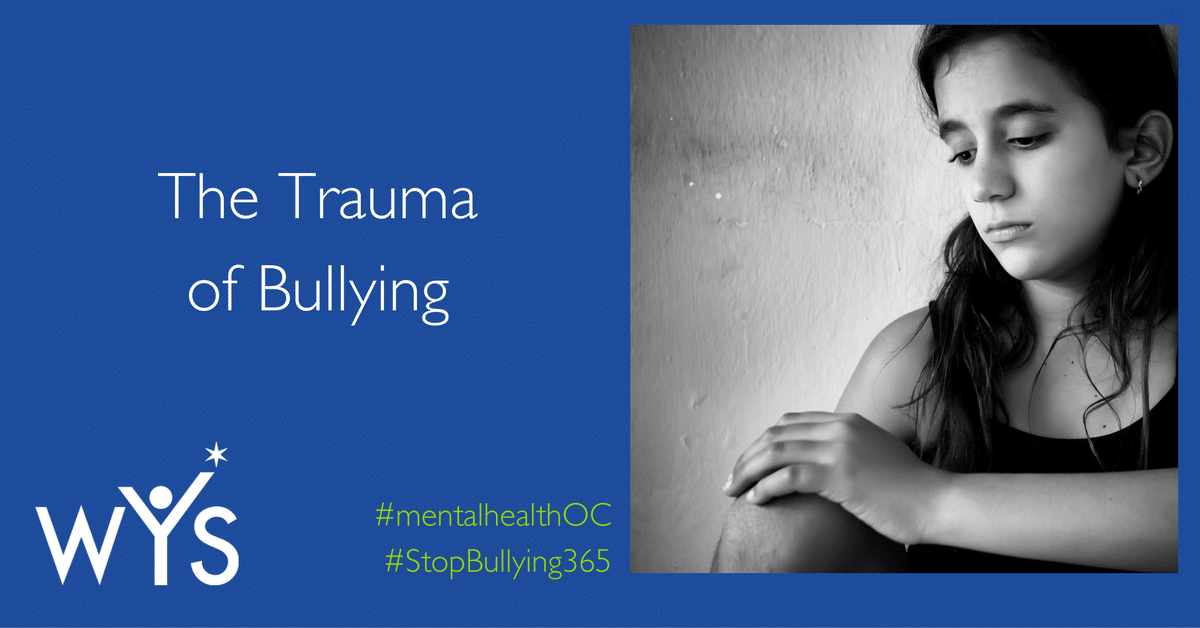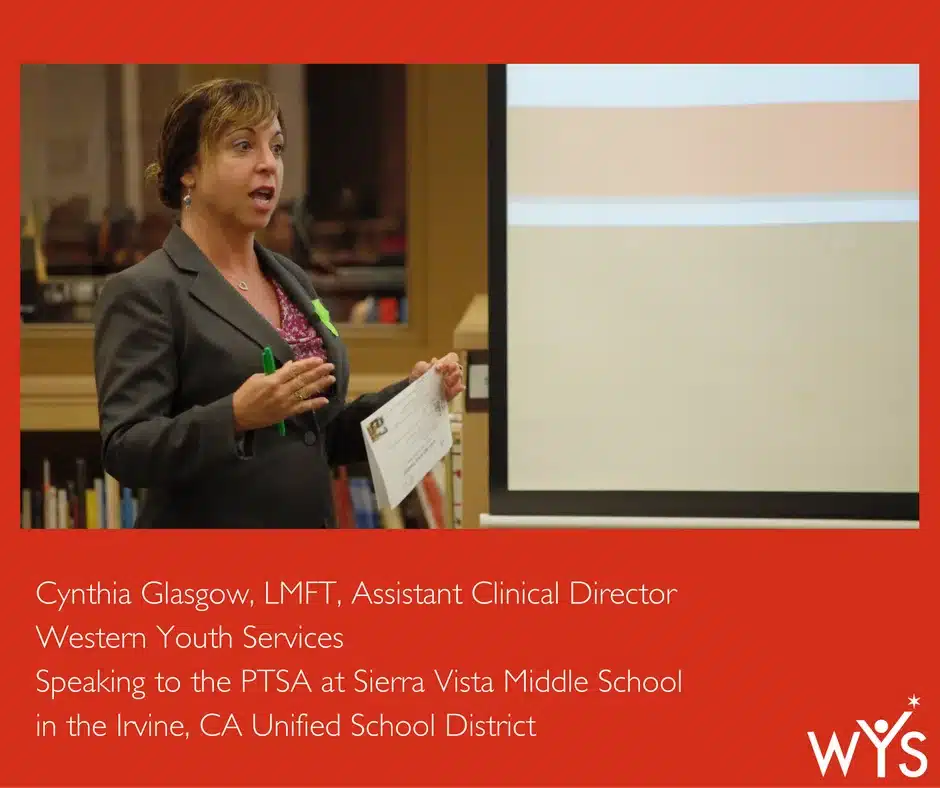
The Trauma of Bullying
Western Youth Services (WYS) has worked with children and families in Orange County, California since 1972. Through the years we have witnessed the many faces of bullying and the effects of the trauma that it causes in a child’s life. Although October is National Bullying Prevention Month, we support the prevention of bullying every day. In this article we are sharing general information about bullying, resources, and a few of the strategies that we employ in our work.
October is #NationalBullyingPrevention Month we support #StopBullying365 #MentalHealthOC – TWEET THIS
Definition of Bullying
The stopbullying.org website has a great definition of the meaning of bullying:
“Bullying is unwanted, aggressive behavior among school aged children that involves a real or perceived power imbalance. The behavior is repeated, or has the potential to be repeated, over time. Both kids who are bullied and who bully others may have serious, lasting problems.
In order to be considered bullying, the behavior must be aggressive and include:
- An Imbalance of Power (real or perceived): Kids who bully use their power—such as physical strength, access to embarrassing information, or popularity—to control or harm others. Power imbalances can change over time and in different situations, even if they involve the same people.
- Repetition: Bullying behaviors happen more than once or have the potential to happen more than once.
Bullying includes actions such as making threats, spreading rumors, attacking someone physically or verbally, and excluding someone from a group on purpose.
NOTE: The description above is focused on school-aged children and that is where we will focus too. Bullies are everywhere, people of all ages are bullied at home, at work, at school, online and in live interactions.
Bullying Can Cause Childhood Trauma
Often bullying will go unnoticed, perhaps it is something small like one child makes fun of another, but bullying can also be more visible, a common occurrence is an incident on the playground or the lunch room at school. One child strikes or pushes another, physical impact results in trauma and when not addressed compassionately and quickly, the adverse effects can be much deeper for all the involved children.
There are many ways that bullying can show up, these are only two examples.
How to Address Bullying
Dania Lizalde, WYS Lead Outreach & Engagement (O&E) Specialist also referenced stopbullying.gov for the strategies below as well as for the content she used for a recent O&E bullying workshop.
- For Staff:
- Try to stay away from labeling the persons involved:
- Instead of “bully”, refer to them as “the child who bullied”
- Instead of “victim” refer to them as “the child who was bullied”
- This will allow the children involved to know that they can change and are not subject to this “role” forever.
- Try to stay away from labeling the persons involved:
- For Parents and Staff
- Help kids understand bullying. Talk about what bullying is and how to stand up to it safely. Tell kids bullying is unacceptable. Make sure kids know how to get help.
- Keep the lines of communication open. Check in with kids often. Listen to them. Know their friends, ask about school, and understand their concerns.
- Encourage kids to do what they love. Special activities, interests, and hobbies can boost confidence, help kids make friends, and protect them from bullying behavior.
- Model how to treat others with kindness and respect.
Anti-Bullying Programs in Action
WYS is committed to stopping bullying in its tracks. Since bullying happens every day in many places, we offer various programs and take the opportunity to inform and educate whenever we can. Particularly with people who spend significant time with children such as parents, educators, teachers and counselors to name a few.
Speaking
Cynthia Glasgow, LMFT, our Assistant Clinical Director recently spoke to the PTSA at Sierra Vista Middle School in the Irvine Unified School District in California. Her presentation titled: Junior High School Transitions, Tips and Tricks for Students and Parents was well received and greatly appreciated by all present. One of the topics she discussed was bullying she explained the various types of bullying and encouraged her audience to never tolerate bullying and always report any instance to school administration. The PTSA asked her to return to provide an extended training.
Experience
Another way is to teach children through experience. Whether they are served by WYS on their school campus, in our clinics, or at a Family Resource Centers, one of our School-Based programs or clients in our offices one of the most effective ways to turn a difficult situation around before trauma sets in is to teach the signs of bullying and best practices for dealing with a situation as it happens.
Fill Your Bucket – Some programs we create and some are adopted. One of the adopted programs we have built into our work is Bucket Fillers which has been busy since 2006 creating bucket filling tools for schools, families, workplaces, and communities through their resources which include: books, presentations, products, and free downloadable resources. Several of our staff are running or have run groups based on their “fill your bucket” concept which teaches respect to others, self-respect, being kind and treating others well. “We utilize it as anti-bullying material.” Margarita Quintero and Desiree Sayre have both used this program over the summer with great success. They have begun to use it again this Fall. Stephanie Schmidt, LCSW, Program Director of Family Resource Centers and SSA Counseling and Parent Education Program.
Lunch Clubs – One of the most popular initiatives launched at schools are Lunch Clubs which were created to build community and address bullying. At Lunch Clubs, kids play games, do arts and crafts and learn skills that help them get along with others. “Mia” (name changed to protect confidentiality) was relieved to have a fun place to go to avoid the girl who had been bullying her. “I think she’s a bully because she doesn’t know how to make friends,” Mia shared with a WYS staff member.This presented an opportunity for an invaluable experience… to model to Mia, the girl and any other student that might be watching, how to turn around a difficult situation. WYS staff invited the girl to Lunch Club to play board games with Mia.
During their play, WYS staff modeled kindness and empathy. In the weeks that followed:
- “The bully” continued to come to Lunch Club.
- Mia and “the bully” continued to play together during Lunch Club.
- Today, Mia no longer calls this girl a bully. Now she calls her friend.
The results are amazing when you take a step back, look at the situation through an objective lens, and react in a positive way. Teaching this technique to children can only be a benefit.
“Lunch Clubs work! Bullies go there to make friends, they stop bullying” – Student – TWEET THIS
Do you have a bullying story to share? Please comment below or share on our Facebook page.

Lorry Leigh Belhumeur, Ph.D.
Chief Executive Officer
Western Youth Services








